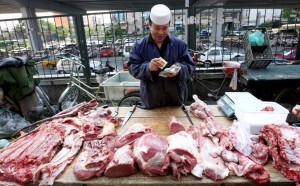In The (Brisbane) Courier-Mail this morning:
In 2013, at least 50 people, mainly children, became ill with E coli O157 at the Ekka.
 Follow-up in the form of a publicly released formal report following an investigation? Nothing.
Follow-up in the form of a publicly released formal report following an investigation? Nothing.
Queensland Health has been warned repeatedly about Q fever outbreaks at the Ekka related to the birthing of goats. Again, follow-up? Nothing.
In 2013, at least 130 people, including 55 nursing home patients, were stricken by norovirus in Ipswich and on the Sunshine Coast. Follow-up? Nothing.
In November 2013, at least 220 people were felled by salmonella and one was killed at Melbourne Cup functions, all linked to raw egg-based dishes served by Piccalilli Catering. Follow-up? Nothing. I even wrote to then health minister Lawrence Springborg and received no response. I guess he was busy with Parliament.
In January this year, at least 130 diners were stricken with salmonella after dining at Brisbane’s Chin Chin Chinese Restaurant. Dozens were hospitalised. Follow-up? Nothing.
Last month, 250 teachers contracted salmonella at a conference and an additional 20 people were sickened on the Gold Coast from the same egg supplier. Follow-up? Nothing. Though, to be fair, Councillor Krista Adams, Brisbane City Council Lifestyle Committee chairwoman, was on ABC radio on Monday saying the Queensland Health investigation into the matter was ongoing.
As a food safety professor in Canada and the US who relocated to Brisbane four years ago to support my French professor wife, I look at these outbreaks and wonder: what does Queensland Health do? What does Safe Food Queensland do? I believe in science, however fallible it may be, and my church is the (ice) hockey arena.
I also believe in public disclosure, especially because these investigations are conducted on the Queensland tax dollar. These are hopelessly ineffective agencies, and I’ve seen a lot of agencies, but these are the worst, especially in terms of public disclosure. Not the people, but the structure and confines in which they work for a pay cheque.
Now we’re told that hundreds of Brisbane restaurants, cafes, bakeries and caterers operate below legal safety standards.
Brisbane City Council says it is waging war on shoddy operators in light of a jump in food poisoning outbreaks.
That’s a war of attrition.
 Instead, Brisbane, and Queensland, could make a few changes to hold the food purveyors accountable.
Instead, Brisbane, and Queensland, could make a few changes to hold the food purveyors accountable.
Mandate training; make restaurant inspection disclosures mandatory, rather than voluntary; and create a culture that values microbiologically safe food.
I was coaching an ice hockey game on the Gold Coast on the weekend and the restaurant we went to afterwards was advertising a petting zoo, at the restaurant.
This is a microbiologically horrible idea. Same with zoos at schools and in malls, such as the one at Fairfield.
Queensland is on track to record its worst year on record for salmonellosis, which has infected more than 2500 people, mostly in the southeast, since the start of the year. The state is also recording spikes in other gastrointestinal illness cases, such as campylobacter (1993), cryptosporidiosis (604) and yersiniosis (180).
Data from the council’s Eat Safe star-rating system shows almost 10 per cent of Brisbane’s 6000-plus food operators operate below legal safety standards.
Queensland taxpayers deserve answers to some basic questions about all of the aforementioned outbreaks: How did the outbreak occur? Was this commodity sourced from a food safety-accredited supplier? Did handling by the caterer contribute to this outbreak? What is Queensland Health’s policy on use of raw eggs in dishes to be consumed raw? Is this policy enforced? Is the investigation closed and, if so, why and when was it closed? Will an outbreak investigation report be created and publicised? Why was the previous update erased from the department’s website and on whose authority? What is its policy on making information public?
This isn’t CSI, with its groovy UV lights that make great television but lousy science. Publicly release all surveillance data on raw eggs in Queensland (or Australia), publicly release the menu items at the Brisbane Convention Centre and Grocer & Grind, on the Gold Coast, where two of their own chefs got sick, and tell chefs to stop using raw eggs in dishes they must craft from scratch, such as aioli or mayonnaise. This is nothing new and we have been documenting the problem for years because it is a global food safety embarrassment. The solutions are there. It’s time for leadership.
Dr Douglas Powell is a former professor of food safety in Canada and the US who shops, cooks and ferments from his home in Brisbane, Australia













